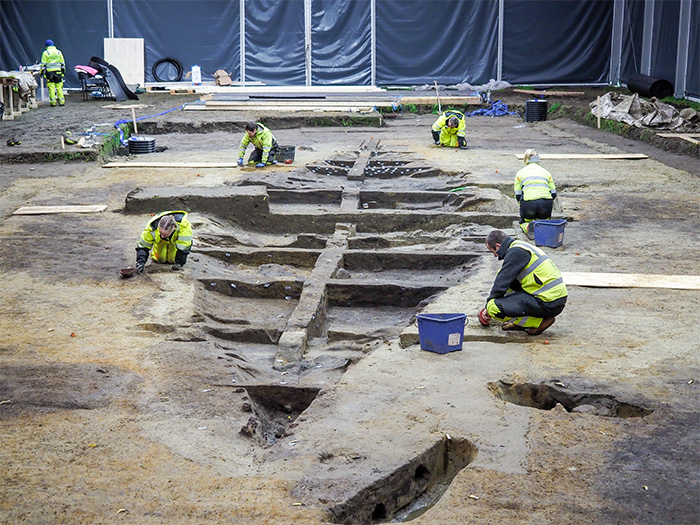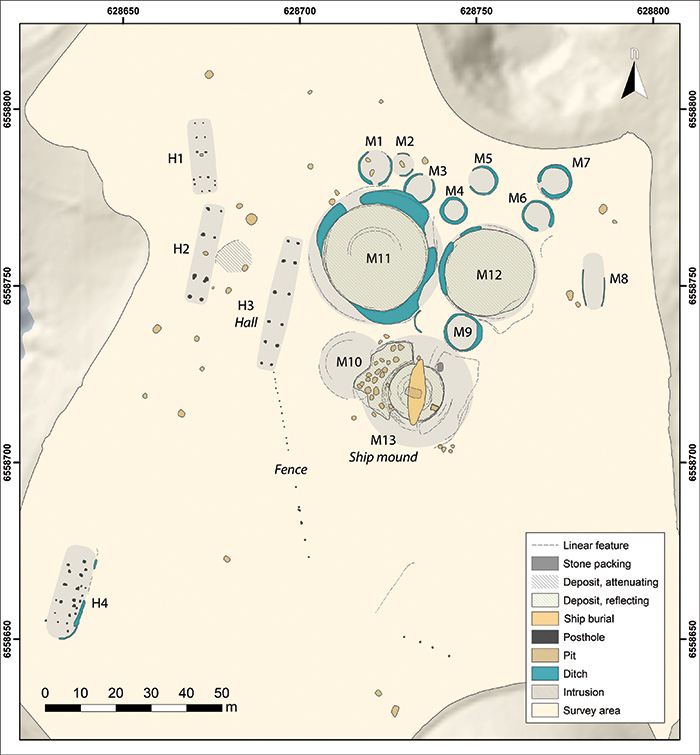A Viking ship burial has been discovered at the site of Gjellestad in south-eastern Norway. It was first identified during a ground penetrating radar (GPR) survey.
A Viking ship burial has been discovered at the site of Gjellestad in south-eastern Norway. It was first identified during a ground penetrating radar (GPR) survey, and is now being excavated by the Museum of Cultural History, Oslo.

The Gjellestad ship burial, seen from the northern stern, during the 14th week of excavations by the Museum of Cultural History, Oslo. [Image: Margrethe K H Havgar, the Museum of Cultural History]
Gjellestad is located in Østfold, on the Viksletta Plain, a 7km2 area of lowland dominated by the Jellhaugen Mound, a large Iron Age funerary monument dating to the 6th century AD. GPR surveys and trial excavations in 2018 and 2019 revealed that the Mound is in fact part of a large complex, with 15 other monumental mounds and at least five buildings, all subjected to ploughing.
More work is needed to confirm the site’s chronology but the survey results, recently published in Antiquity (https://doi.org/10.15184/aqy.2020.39), suggest that Gjellestad started out as an ordinary mound burial ground in the Iron Age, and was only later transformed into a high-status cemetery with monumental burial mounds, ceremonial hall buildings, and the ship burial. The Late Nordic Iron Age (AD 550-1050) was a time of great change, and tensions over control of the landscape were common. Sites like Gjellestad would have been used as power symbols by communities looking to demonstrate their connections to the land and to legitimise their social and political position.

The results of the geophysical surveys showed evidence of multiple mounds, including the ship burial (M13) and several other structures, which had been flattened by ploughing on the surface. [Image: Kartverket/CC-BY-4.0; figure by L Gustavsen, Antiquity Publications Ltd]
The ship burial reflects the ultimate display of status, wealth, and connection. Boat burials emerged in northern Europe in the 1st century AD and disappeared with the introduction of Christianity in the 10th and 11th century. Several hundred boat burials are known in northern Europe, but ocean-going ships (vessels measuring more than 12m long) are rare.
Excavations of the Gjellestad ship burial, which have been going on since June 2020 and are almost complete, appear to support the findings of the GPR survey, which identified a shape 19m-20m long and 4m wide, representing the lower part of the vessel. The upper section has been completely destroyed by ploughing, but it is thought that, with the stem and stern, the craft’s original length would have been closer to 21m.
Through examination of the ship’s keel, researchers were able to establish that its timber was felled after the year AD 732, so it is believed that the burial probably dates to the period between the late AD 700s and the beginning of the 900s. This aligns with the other Viking ship burials known in the Oslo Fjord region, which are all 9th or early 10th century in date.
In addition to the importance of the ship burial itself, the discoveries at Gjellestad indicate that the site remained significant for several centuries. It is hoped that future work will uncover more about its role as a power centre in the landscape.
This article appeared in issue 105 of Current World Archaeology. Click here for more information about subscribing to the magazine.
Related Post
A shocking documentary proves that mermaids do exist
SHOCKING Revelation: Thuya, Mother of Queen Tiye, Was the Grandmother of Akhenaten and Tutankhamun—What Ancient Egyptian Secrets Did She Leave Behind?
Breaking News: Astonishing Discoveries at Karahan Tepe Confirm an Extraterrestrial Civilization is Hiding on Earth, and NO ONE Knows!
Breaking News: Researchers FINALLY Discover U.S. Navy Flight 19 After 75 Years Lost in the Bermuda Triangle!
NASA’s Secret Investigation: Uncovering the Astonishing Mystery of the UFO Crash on the Mountain!
Explosive UFO Docs LEAKED: Startling Proof That Aliens Ruled Ancient Egypt!